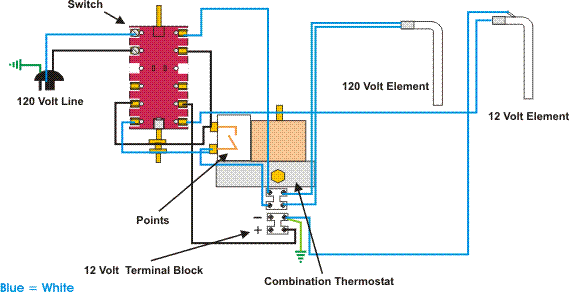Dave's Place
Dometic Manual Refrigerator Electric Controls
Before attempting any repairs or testing, check out the gas safety and electrical safety pages.

Understanding the electrical system in a manual refrigerator is relatively simple as long as you know electricity must complete a circuit for something to work. A circuit is a loop beginning at a power source, normally passing through a wire, then through some sort of resistance (a heat element, for example), and eventually returning to the power source along a different path than it originated. Switches and thermostats in the circuit control the designated resistance by breaking the circuit and turning it off. With a 12 volt circuit, the metal chassis of the refrigerator can be the return "wire", or negative (-) side.
Electric Operation
The switch (operated by the selector knob at the front of the refrigerator) is the
heart of the electrical system on a manual refrigerator. Both 120 volt and 12 volt (optional) are wired to the
switch. The switch keeps the two voltages apart while applying the selected voltage to the thermostat and the
appropriate heat element. For example, when 120 volt is selected, one leg of the 120 volt circuit goes
straight to the 120 volt heat element and the other leg goes to the thermostat and on through to the heat
element. At this point in time, 12 volt power goes no farther than the switch. The opposite is true when 12
volt is selected; no 120 volt past the switch, and 12 volt to the appropriate components. When gas is selected,
both circuits are open.
Inside the electric side of the combination thermostat are a set of points that open and close, depending on the temperature of the refrigerator. When the points are closed, electricity flows through to the heat element, causing it to heat the cooling unit. A capillary tube (not shown) running from the thermostat to the interior of the refrigerator senses the temperature inside and activates the thermostat. The points open and close depending on the temperature of the refrigerator.
Troubleshooting
Diagnosing an electrical problem usually involves testing for the presence of voltage at various points along
the circuit. Naturally, you will need some sort of test apparatus to conduct the tests. A test bulb, of the
right voltage, with wires will work, or, preferably, a volt meter. First, be sure you have power to the
refrigerator. Is there power at the 120 volt receptacle, or 12 volt at the 12 volt connection terminal? The
most common electrical problem is the heat element not getting hot. A burned out heat element is a good
possibility in such a case, so testing the connections to the heat element for voltage would be the next step.
If you have voltage to the heat element and it doesn't get hot, it is bad. If
there's no voltage to the heat element, then work backwards toward the thermostat and switch.
A thermostat problem is usually a case where the thermostat is either stuck shut or stuck open. Testing the connections on the thermostat while in operation will give you the answer you need. However, consider the temperature inside the box before jumping to any conclusions. Should the contacts inside the thermostat be open or closed at the given temperature? Having someone rotate the thermostat knob from one extreme to the other can also be helpful. If the thermostat fails to either open or close at the appropriate time, it needs to be replaced.
Dometic Manual Refrigerator Controls
RV Refrigerator Home
This RV refridgerator information was originally located on rvmobile.comRV Mobile Inc. 11715 HWY 99, Everett, WA 98204
The owner of RV Mobile Inc. apparently suffered a heart attack and the original website was shut down.
It has been reposted here to preserve this wealth of information RV refridgerator information.